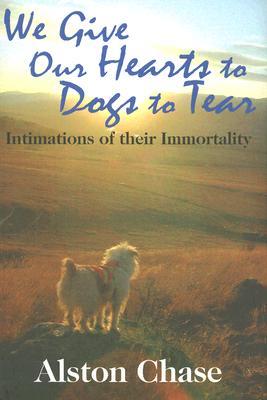When Tibbie came into my life, I was already past my 40th year. After a few weeks I marveled how I had ever lived without a dog. As a first dog, this 14-pound West Highland terrier would set the standard for those to follow—kindhearted, gentle, loving, spirited, playful, patient, trusting, intelligent, obedient, mischievous, a beauty to watch, and a joy to snuggle with; but also strong willed, determined, and a born ratter. She and her pal Willie, also a Westie and six months her junior, would corner and kill many a field mouse at their various homes in California, Maryland, and Virginia. At nine years of age, she survived a coyote attack, but her life hung in the balance for 48 hours. When she recovered, she was the same old brave and loyal dog, and when she finally succumbed to cancer a week shy of 17, we still wanted to hold on to her. I will never be the same person for having known her and will keep her in my heart to my dying day.
For this reason, reading Alston Chase’s new book, We Give Our Hearts to Dogs to Tear, was a cathartic experience. Anyone who has shared his life with a dog knows the unique joy and intense grief inextricably bound up in the relationship. We console ourselves that the dogs, whose life spans are so much shorter than ours, at least don’t have to endure our loss, the loss of their master, the primary focus of all their devotion, care, and affection.
Chase’s book chronicles more than a quarter-century of a family’s history with three main characters: the dogs, the humans, and the land. The dogs are mostly Jack Russell terriers, and as we get to know each one, from birth to death, sometimes slowly from disease, sometimes suddenly from a wild predator or a human vehicle, Chase uses their lives to reflect on the two-century history of the Jack Russell terrier in America and the British Isles.
The humans are the author, his wife, Diana, and individuals raising and caring for these dogs widely scattered across time and place. What emerges is a portrait of this particular type of dog, the hunting Jack Russell, and the people devoted to him or her. The land is Montana—in the late 70’s, still a wild and rugged place. By the time the book closes in the first decade of the 21st century, the land has undergone much of the massive shrink-wrapping that is suffocating wild places and the quality of life outdoors everywhere. The Jack Russell is not a hothouse flower. He revels in the open space, the wildness, and even the danger. The more we watch him in Chase’s narrative, the more we come to see ourselves. For we, human animals, also need these things to thrive.
Chase says it best:
No matter where we live or what we do, love of the land lies in our blood. For twelve millennia, dogs and people lived on the land, working, herding, defending, rescuing. And when, beginning two hundred years ago, people began moving to cities they yearned for the pastoral way of life all the more. They still do. Dogs preserve for us an emotional connection to our bucolic past that remains in memory and imagination. And when they demand we take them for walks, they reawaken this connection. They become guides in a journey to rediscover our own genetic roots.
I shouldn’t have been surprised that woven throughout the narrative is an existential contemplation on eternity. Not surprised, because each time a dog leaves, as with the loss of a beloved human, we are forced to confront the unanswerable questions we spend most of our time ignoring. Finally then, this book is a philosophical memoir, a heart-rending meditation on the extraordinary mystery that is the bond between dog and man.
Immediately upon closing the book, I said a prayer for Tibbie, Willie, and Yum-Yum, who had recently been taken by a black bear—then settled down on the faded and much-abused oriental rug with Tobey, Doogie, Penelope, and Patou. They were waiting.
[We Give Our Hearts to Dogs to Tear: Intimations of Their Immortality, by Alston Chase (Edison, NJ: Transaction) 235 pp., $34.95]

Leave a Reply